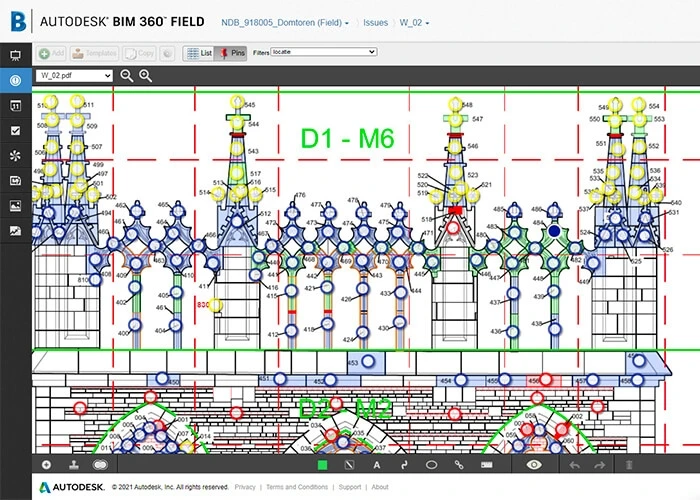& Construction

Integrated BIM tools, including Revit, AutoCAD, and Civil 3D
& Manufacturing

Professional CAD/CAM tools built on Inventor and AutoCAD
Sitting at the heart of Utrecht’s old city center is Domtoren: a 14th-century cathedral spire that has been cocooned in an impressive net of scaffolding since the middle of 2020, awaiting extensive and badly needed restoration. Now, the role of BIM (Building Information Modeling) in this landmark restoration project is ensuring faster, more sustainable, and more cost-effective heritage preservation practices for tomorrow.
It’s hard to miss Utrecht’s Domtoren. Taller than 367 feet (112 meters), the 700-year-old Dutch church tower dominates the old city’s skyline. It’s a powerful reminder that, despite the modern office blocks vying for attention, the past is always present in European architecture.
A blend of new and old is vital to the historic spire’s restoration, with digital tools helping traditional craftspeople refresh the tower’s weathered stone facades. They’re using data to re-create each element brick by brick, ornament by ornament—10,000 in all. Historically, this would have been a big job. Today, data-driven construction technologies are making the process smoother, enabling more granular project management as multiple data points are captured, cataloged, visualized, and shared for even the smallest piece.
Although some restoration work was done on Domtoren in 1975, centuries of wind, rain, snow, and sun have taken their toll on the landmark’s exterior. Despite careful and regular maintenance, time has chipped away at the natural stone and caused the grout between blocks to slowly disintegrate. It’s weathered considerably and now poses a safety risk.
Defects in the stone and brick are the main focus, along with rusting anchors in the tower’s octagonal lantern, which still holds much of the original structure’s 14th-century building material. A host of carved wooden elements, panes of stained glass, the tower’s main clock, and the lead and slate pieces that comprise the spire all need attention, too. By 2024, when the restoration is expected to be complete, close to 600 cubic meters of stone will have been replaced.
Luckily, this massive undertaking is all being led by specialist restoration contractor Nico de Bont, an independent company that forms part of TBI. Nico de Bont is well-known in the Netherlands for the large-scale natural stone restoration of the St. John’s Cathedral in ’s-Hertogenbosch and the Eusebius Church in Arnhem.
Each day, the firm sends a team of specialist craftspeople to climb the 328-foot scaffolding now enveloping the tower. This 39-level exoskeleton is an impressive structure in itself. Built by ROJO Steigerbouw, it took half a year to complete, using more than 31 miles of pipe, 40 kilometers of wooden planking, and 440 tons of material. From that solid footing, the project’s architects and artisans can conduct painstakingly detailed restorations on each individual piece of Domtoren.
The agreed objective is to make the tower better than before while keeping it looking essentially the same. Modernization isn’t a goal. What city heritage preservation experts want is a safer and stronger version of the exterior that, in terms of presentation, doesn’t deviate much from the tower’s original magnificent self.
That means replacing thousands of different stones and matching the originals’ color and texture while also preserving as much historical material as possible—not an easy task. None of the stone types came from the Netherlands. Instead, many were quarried from Germany, Belgium, and France. Even once new materials had been sourced, the work required more than just cutting squares and rectangles.
“It’s not only flat pieces,” says Tommy van Beem, BIM manager at Nico de Bont and TBI BIM program manager. “In many cases, we have to re-create detailed ornaments that were originally hand-carved by medieval artisans.”
Heritage preservation can’t be freestyle. Capturing detailed information about individual pieces to be restored and getting it to the right craftspeople at the right time is essential to the project’s success.
“Using digital tools enabled us to make our own workflow and create our Block Registration System (BRS) to accommodate all that complexity—it was a huge advantage,” he adds. “These tools made capturing a big volume of detailed information faster and then gave the data practical value for everyone involved in the project. Recording all activities such as filling in block information is necessary for the future and new restoration work over 30 years.”
In the past, a restoration project of this scale would need more people, more budget—and, in both cases, more time. Information about restored components might have been captured manually on paper, or in a lengthy spreadsheet, with loads of data entry and uploading of individual images. With Autodesk BIM 360, Nico de Bont and the project architects were able to do a detailed assessment of the elements in need of restoration.
Individual bricks, stones, and ornaments all get their own entry in the Block Registration System, along with a QR code for tagging. Information captured includes dimensions, material, features, location, images, status, issues, actions taken, and next steps required. That hugely speeds up the restoration process. Information is richly detailed, accurate, and visual—with everything instantly accessible to everyone on the project who needs it.
This includes workers on-site, who can now use a tablet to pinpoint the exact location of the tower-facade piece they need to work on next. Government heritage experts among the project’s stakeholders can also access the database, allowing them to pinpoint the oldest pieces for reclamation and historical importance. Even specialist suppliers, like those who have to re-create ancient ornamental shapes and figures, can gain access to the system for a data model with exact dimensions to work from.
“Every single brick and stone gets an entry in the system,” van Beem says. “So if you’re looking at a brick on the tower’s north face at level three, you can type the number of the stone into a tablet or search by description, location, status, material, and so on. The stones are also QR-coded and tagged, so they can also be scanned to see their profile instantly.”
That level of detail leads to fewer errors and missteps, reducing costs and time lost due to correcting mistakes. All together, there are close to 100 data points that can be cataloged for any one piece. Multiply that by 10,000 pieces—every one of them different—and gathering it all is a monumental task. Digital data capture simplifies and largely automates the chore.
Now fully underway, the 30-million-euro ($36.4 million) project is due to finish in 2024; already, it promises to be a huge success. BIM has helped the Domtoren team secure maximum preservation of historical material, ensuring most of the landmark’s original stones are recycled through the restoration process. Thanks to this improved circularity, Nico de Bont projects that its mix of digital management and traditional hand restoration will not only ensure the project is more environmentally sustainable but also save the city of Utrecht 10% over the project’s lifespan.
“What we’re doing is using technology to replicate a process that’s seven or eight centuries old,” says Nico de Bont Chairman Boudewijn de Bont. “We won this project because we could demonstrate respect for both history and craftsmanship, combined with a modern way of executing the work. We also had to show we operated according to lean and supply-chain-integration principles, as well as keep costs on track. With 10,000 pieces to manage over five years, the control that digital construction tools like BIM 360 provide is vital to success—especially when you consider the collaboration and detailed information sharing that has to happen across a long chain of suppliers and contractors.”
Domtoren survived a tornado in 1674 and severe damage during Holland’s civil and religious upheaval in the 16th century. As the bell tolls for paper-based, manual processes in heritage restoration projects, BIM technology is helping ensure this signature piece of Utrecht’s built environment survives another 700 years.
Mark de Wolf is a freelance journalist and award-winning copywriter specializing in technology stories. Born in Toronto. Made in London. Based in Zürich. Reach him at markdewolf.com.
AECO
AECO
Image courtesy of Art Graphique & Patrimoine.
POV









